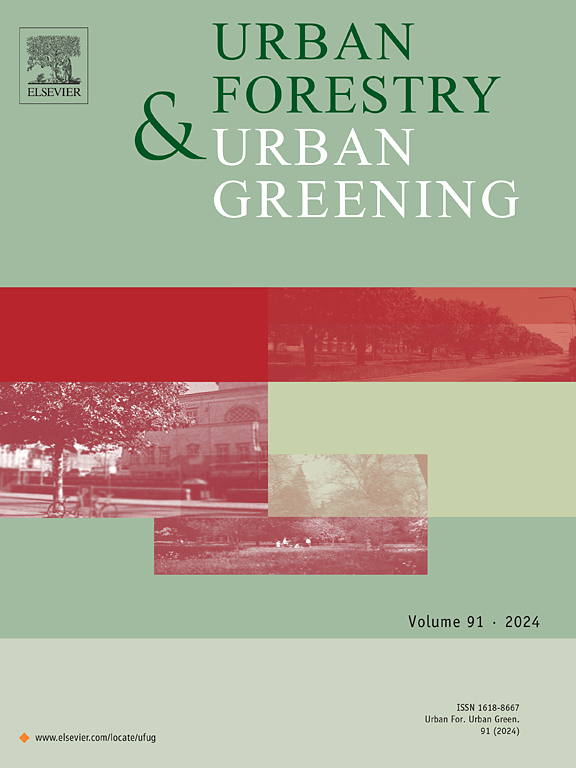居住区绿地对鸟类的价值:与不同规模城市公园的比较研究
IF 6
2区 环境科学与生态学
Q1 ENVIRONMENTAL STUDIES
引用次数: 0
摘要
人类居住区的持续扩张所造成的栖息地丧失、支离破碎和土地利用变化对全球生物多样性构成了威胁。居住区绿地(RGs)在城市地区非常普遍,不仅有益于人类健康和福祉,还提供了保护生物多样性的机会。虽然住宅绿地被建筑物和频繁的人类活动分割得支离破碎,但与城市公园相比,人们对住宅绿地支持和保护生物多样性的能力知之甚少。为了评估这些绿地支持生物多样性的能力,我们比较了公园绿地与不同规模的城市公园的鸟类物种多样性、群落组成和影响因素。结果表明,与中等规模的城市公园类似,公园绿地也具有较高的鸟类物种丰富度和丰度。与水体的距离是影响区域观察区和城市公园鸟类物种丰富度的唯一共同因素。此外,区域保护地受到本地鸟类和城市居民的青睐,区域保护地的鸟类群落也与城市公园不同。研究结果表明,区域观察站可以为鸟类保护提供机会,也是人类与自然界中的动物进行互动的最便利场所。我们建议城市规划者和管理者考虑蓝绿空间和栖息地建设,以改善居住区内的鸟类多样性。本文章由计算机程序翻译,如有差异,请以英文原文为准。
The value of residential green spaces for birds: A comparative study with urban parks of different scales
Habitat loss, fragmentation and land-use change caused by the continued expansion of human settlements pose a threat to global biodiversity. Residential green spaces (RGs) are widespread throughout urban areas, providing benefits to human health and well-being and opportunities to conserve biodiversity. While RGs are fragmented by buildings and frequent human activities, little is known about their ability to support and conserve biodiversity relative to that of urban parks. To assess the ability of these green spaces to support biodiversity, we compared the bird species diversity, community composition, and influencing factors in RGs with those in urban parks of different scales. Our results revealed that, similar to medium-sized urban parks, RGs are associated with high bird species richness and abundance. Distance from waterbodies was the only common factor affecting bird species richness in RGs and urban parks. Moreover, RGs were favoured by native birds and urban dwellers, and the bird communities in RGs differed from those in urban parks. The results demonstrated that RGs can provide opportunities for bird conservation and serve as the most convenient place for humans to interact with animals in nature. We recommend that urban planners and managers consider blue–green spaces and habitat construction to improve bird diversity within residential areas.
求助全文
通过发布文献求助,成功后即可免费获取论文全文。
去求助
来源期刊

Urban Forestry & Urban Greening
FORESTRY-
CiteScore
11.70
自引率
12.50%
发文量
289
审稿时长
70 days
期刊介绍:
Urban Forestry and Urban Greening is a refereed, international journal aimed at presenting high-quality research with urban and peri-urban woody and non-woody vegetation and its use, planning, design, establishment and management as its main topics. Urban Forestry and Urban Greening concentrates on all tree-dominated (as joint together in the urban forest) as well as other green resources in and around urban areas, such as woodlands, public and private urban parks and gardens, urban nature areas, street tree and square plantations, botanical gardens and cemeteries.
The journal welcomes basic and applied research papers, as well as review papers and short communications. Contributions should focus on one or more of the following aspects:
-Form and functions of urban forests and other vegetation, including aspects of urban ecology.
-Policy-making, planning and design related to urban forests and other vegetation.
-Selection and establishment of tree resources and other vegetation for urban environments.
-Management of urban forests and other vegetation.
Original contributions of a high academic standard are invited from a wide range of disciplines and fields, including forestry, biology, horticulture, arboriculture, landscape ecology, pathology, soil science, hydrology, landscape architecture, landscape planning, urban planning and design, economics, sociology, environmental psychology, public health, and education.
 求助内容:
求助内容: 应助结果提醒方式:
应助结果提醒方式:


